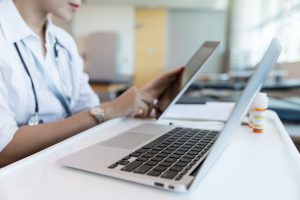 Written by: Erica Pitsch, PT, DPT, Neurologic Clinical Specialist
Written by: Erica Pitsch, PT, DPT, Neurologic Clinical Specialist
Let’s face it, we’re all in turmoil at the moment. None of us have ever faced the surreal circumstances that we find ourselves in since March of 2020. The more we learn about the truly elegant villain that is the 2019 Coronavirus, helplessness is an emotion that can easily become part of the kaleidoscope of feelings we’re all having right now. The purpose of this article is to give you a few ideas on some positive things you can do for public health in general and our stroke survivors in particular. The following is an update to the best of my knowledge as of May 10, 2020.
Shout it from the Rooftops: Increase Awareness of Acute Stroke, Especially for the Young
First: Many participants in my stroke class have observed this, and it is confirmed by epidemiological data: globally, stroke is becoming more prevalent among the young, only partially explained by an increase in lifestyle-related risk factors1. So first, keep on promoting cardiovascular exercise, especially now in our high stress circumstances.
Second: Recent letter in the New England Journal of Medicine reported five cases in a of young adults (under 50) who presented with large vessel strokes, all of whom were COVID-19 positive. In a similar time-frame, the hospital would normally get .71. Now, some may roll their eyes at such fuss made over a small number of people, especially in light of the global trend in increasing strokes, and the NEJM was very cautious about saying this was preliminary data2. And still, it is worth noting for a number of reasons: of the five, two were otherwise asymptomatic and one only had lethargy as a symptom. Two did not have stroke risk factors. Tragically, at least one delayed seeking medical attention because of fear of catching COVID-19. And finally, we are learning that COVID-19, causes systemic inflammation and what is being called “sepsis-induced coagulopathy” with high D-dimer levels 3, placing people at higher risk of stroke and other clotting disorders. Three of the five stroke survivors had D-dimer level several times above acceptable levels. So what do we do? Share the BE FAST mnemonic everywhere, social media especially. Ask any community zoom meeting to make an announcement ahead of time. Most importantly, reach out to people who may not have access to digital information. Wear it on a t-shirt when you go on your social distancing grocery runs, place signs on the bus stop, anywhere and everywhere. As a reminder, BE FAST stands for Balance, Eyes (blurred, double vision), Facial droop, Arm weakness, Speech difficulties, and Time to get to the hospital4.
 Ready or Not, Here it is: Telehealth and Remote Therapy
Ready or Not, Here it is: Telehealth and Remote Therapy
Prior to the shelter in place order, the vast majority of people I saw for telehealth had facial nerve injuries- the perfect, low risk population to work with remotely. I was personally leery about seeing people with other mobility deficits via telehealth for fear of watching my patient fall from a distance. Now, if the patient has the tech or a family member to help, I’ll give it a shot- I just make sure to have their nearby emergency contact phone number at hand.
Challenge One: For those who have the Tech, but not the Buy-In
Identified barriers to technology adoption include not thinking it will be effective, or that it will be hard to use. The good news is recent reviews of the literature have found that telerehabilitation was at least as effective as usual and customary care for motor recovery, though, as always, more and better research should be done5,6. Another important benefit described by participants in a telehealth study was the social connection7, and this study was conducted before the isolation induced by shelter in place guidelines. From my experience thus far, this has been very important for many of my patients. Additional benefits described by the APTA include convenience, access, and home safety8. Some of the strategies we have used in using telehealth include plugging the laptop into my home TV or larger monitor, doing the 5 x sit to stand, and a Costco crate for the step component of the Berg. Also, making sure you have the patient’s nearby emergency contact number at the ready, especially if they are at home alone. What are your favorite strategies for testing and treatment?
Telehealth Benefits for Physical Therapists: https://www.choosept.com/resources/detail/6-reasons-to-consider-telehealth-physical-therapy
Challenge Two: Access
One of the more heartbreaking challenges is those people who cannot participate in telemedicine because they don’t have the equipment or the connectivity for a digital visit. This is true not only in the US, but around the world- but there are options. One of the strategies to improve healthcare for developing countries is using apps on a smartphone. According to a 2019 study of 11 developing countries by the Pew Research Center, a median of 53% of adults have access to a smartphone, whereas only 34% have access to a computer or tablet9. Because of the accessibility of smartphones, Health 4 the World, a global nonprofit, has created an app for stroke management that includes education, medication reminders, exercises with animations and videos demonstrating higher level upper limb tasks. Funny story- when it was launched in India, Bhutan, and Nepal, the feedback they got was the exercises were “too easy”, so we added more complex upper limb tasks. It is free on the app store and is available in seven languages (www.health4theworld.org).
We Can Do This
Rehabilitation professionals are some of the most creative, adaptive, and positive people I know. Our role as health care providers and educators is more important now than it has ever been. How will you spread the word about stroke awareness?
For more information on stroke rehab, check out my course, “Overcoming Challenges in Stroke Rehabilitation.”
References:
- Hathidara MY, Saini V, Malik AM. Stroke in the Young: a Global Update. Current neurology and neuroscience reports. 2019;19(11):91.
- Oxley TJ, Mocco J, Majidi S, et al. Large-Vessel Stroke as a Presenting Feature of Covid-19 in the Young. The New England journal of medicine. 2020.
- Hess DC, Eldahshan W, Rutkowski E. COVID-19-Related Stroke. Translational stroke research. 2020:1-4.
- Aroor S, Singh R, Goldstein LB. BE-FAST (Balance, Eyes, Face, Arm, Speech, Time): Reducing the Proportion of Strokes Missed Using the FAST Mnemonic. Stroke. 2017;48(2):479-481.
- Sarfo FS, Ulasavets U, Opare-Sem OK, Ovbiagele B. Tele-Rehabilitation after Stroke: An Updated Systematic Review of the Literature. Journal of stroke and cerebrovascular diseases : the official journal of National Stroke Association. 2018;27(9):2306-2318.
- Laver KE, Adey-Wakeling Z, Crotty M, Lannin NA, George S, Sherrington C. Telerehabilitation services for stroke. The Cochrane database of systematic reviews. 2020;1:Cd010255.
- Chen Y, Chen Y, Zheng K, et al. A qualitative study on user acceptance of a home-based stroke telerehabilitation system. Top Stroke Rehabil. 2020;27(2):81-92.
- Crawford CS. Six reasons to consider telehealth physical therapy. American Physical Therapy Association. Published 2020. Accessed May 10, 2020.
- Silver LS, Aaron; Johnson, Courtney; Taylor, Kyle; Jiang, Jingjing; Anderson, Monica; Rainie, Lee. Mobille connectivity in emerging economies. Pew Reserch Center. Published 2019. Accessed May 10, 2020.

Wow. Thank you so much for the opportunity to see this blog. I am a PT starting Telehealth soon and so appreciate some of the pearls of wisdom you shared. Especially about tips for having the emergency number available, plug in to a TV. Thank you so much for the resources included in the blog.
Thank you for being a resource.